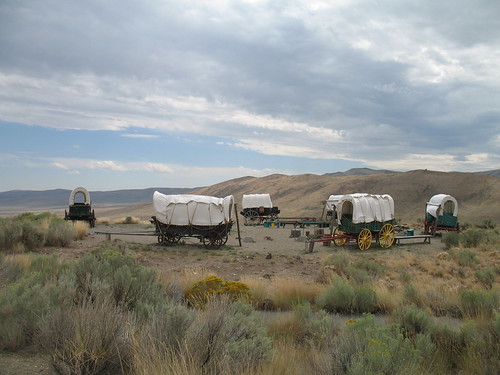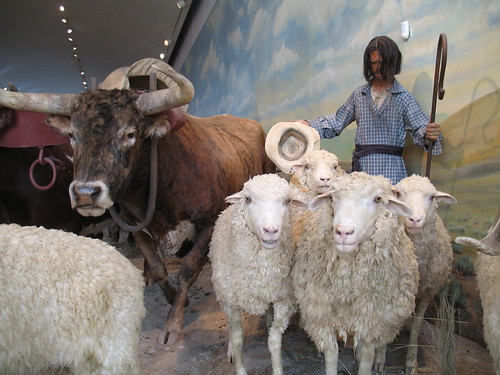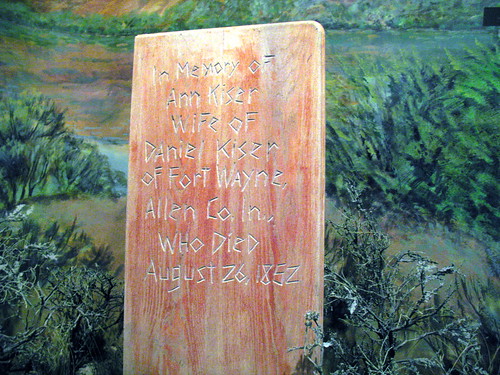August 27, 2008
(Spotty Internet connections continue to bedevil these updates. Being sleepy at the end of each day's journey is also to blame.)
Oregon Trail Diary
Day 9
Distance: 338 miles
Pace: Steady
Health: Good
Weather: Hot
Meals: Filling
We are nearing the end of the Oregon Trail, and supplies are low in the Volks Wagon. We have but two more days of Q-tips, and K. has relapsed in her addiction to Easy Cheese; that poor woman, so long the bedrock of our journey, now makes only half-hearted attempts to pretend the accursed spray-cheese is going on crackers instead of directly into her mouth. I am not without struggles of my own, of course; having traveled alone through many foreign lands, I failed to anticipate that a traveling companion would expect me to change my underwear regularly. (Girls!)
Yesterday, we re-joined the main trail in western Idaho, and today, we crossed over the border into Oregon. Despite being critically low on supplies, we have decided to skip Fort Bridger and seize the fading summer by heading straight for The Dalles. I have never been to the Pacific Northwest, and eastern Oregon quickly obliged my expectations with a heavy shroud of fog and a funereal march of tall, gorgeous pine trees.
Our only major stop for the day was the National Historic Oregon Trail Interpretive Center in Baker City, Oregon. (K. was curious why they won't just call themselves a museum, as "interpretive center" is really a rubbish term. I don't know, although I do work for a library that is extremely sensitive about being called a museum, so there may be issues at work.) I didn't understand why it was located in Baker City (absent from the game and historical accounts) until we were actually there. As it turns out, this was the point where settlers caught their first glimpse of the Blue Mountains, which meant the end was finally within reach. There are also some wheel ruts in the field below from the many thousands of wagons that passed through here. A marker noted that wagons usually reached this point in late August or early September; at last, for the first time in this trip, we are on pace!
The interpretive center is surprisingly excellent. Although the one in Independence is a must-visit for the load-a-wagon and ox-democracy, the exhibits in this one were jam-packed with disheveled mannequins voiced by intensely earnest actors:
This fellow argued incessantly with his ox and sheep over which way to go, and voiced doubts about their prospects for survival. He had not earned the trust of the animals, because the argument kept flaring up every couple of minutes. There were complex relationships at work there. Even better was a husband and wife on the verge of starvation, sounding out the concept of "swap" with some sock-crazy Indians. The Indians had an apparently inexhaustible supply of salmon, and were willing to use those salmon to satiate their equally inexhaustible desire for socks. The wife ended the exchange by pledging to hurry back to their wagon to knit some more socks.
The signage also displayed a wicked sense of humor. Here's an example, from the trip preparation section, with the question listed on the top flap:
Q: Harriet Malinda has learned to play the melodeon, a sweet reed organ that looks like a little piano. Can she take it in the wagon?
Lift up the flap for the answer:
A: Yes, she can take it, but will have to throw it out at Devil's Gate. The death of three oxen are one factor. Harriet Malinda's death from cholera is another. There's no one left to play the thing.
What do you add to that? And there was also crucial anthropological evidence to be uncovered:
This grave marker may be conclusive evidence that pioneers of the 1800s played the Oregon Trail differently from kids in my third grade computer lab, who never would have wasted their precious character count on details like that.
All in all, the National Historic Oregon Trail Interpretive Center was exceptional, and ranked as a favorite stop for both of us. (We also appreciated that, unlike everything else we've seen and read so far, this place had some discussion about what the pioneers actually did when they reached Oregon. There were illuminating quotes from the diary of a settler named James Nesmith, who I'm going to assume was the ancestor of Mike Nesmith from the Monkees.)
Tonight, we make camp at The Dalles, on the banks of the roaring Columbia River. The Barlow Toll Road is an option, as is a raft. Some pioneers, having abandoned all of their possessions, are wind-surfing on the river; their progress is slow and frequently devolves into circles, and we pity them.
Tomorrow, no force on Earth can keep us from the end of the Oregon Trail.



